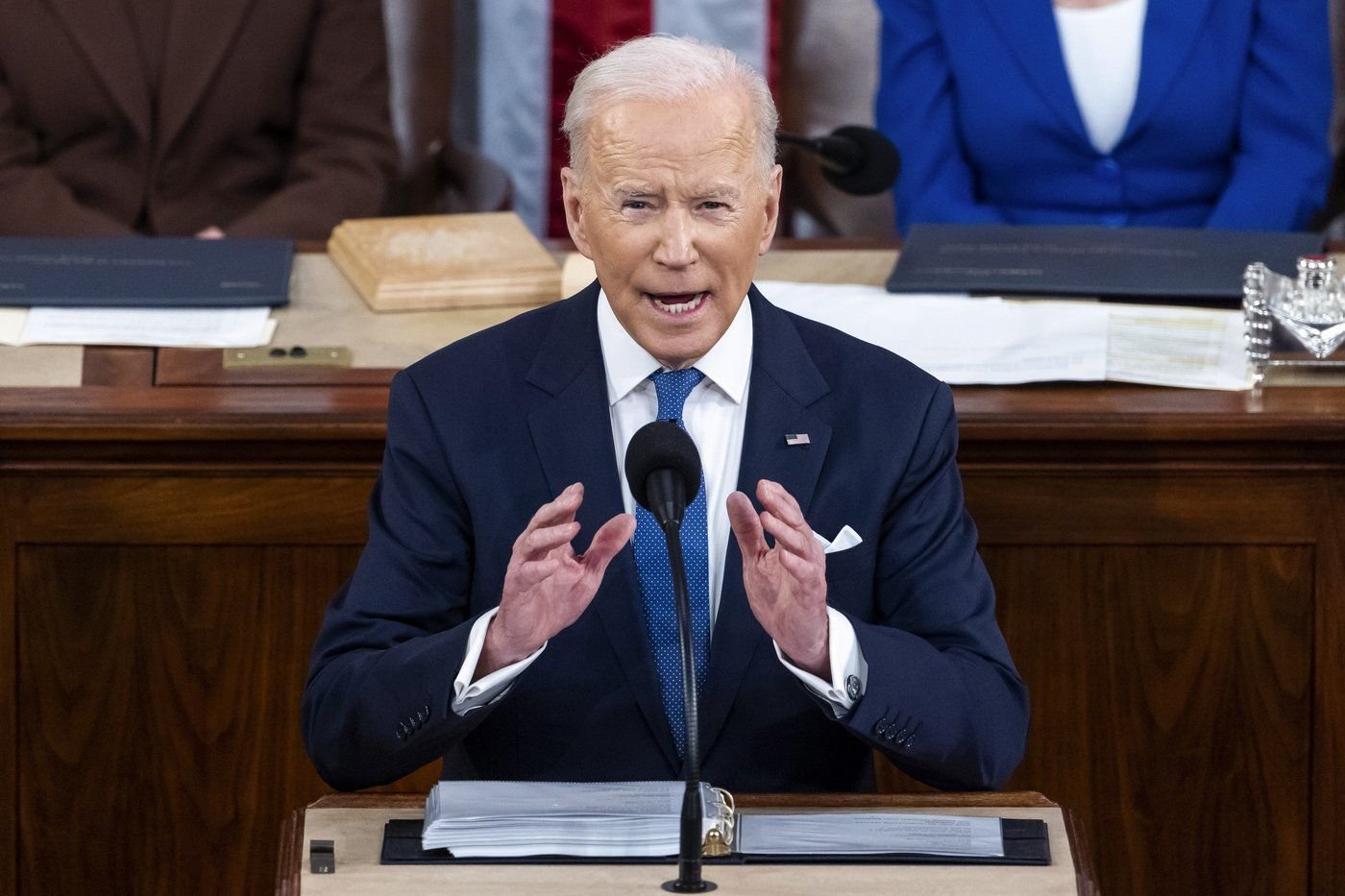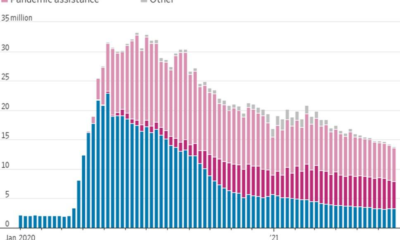Money
Will Biden’s second state of the union take a less protectionist approach to Canada?

A new poll suggests a majority of Canadians still see the United States as their country’s closest ally, even in an age of isolationism and protectionist policies.
The online survey by Leger for the Association for Canadian Studies found 69 per cent of respondents still see the U.S. as Canada’s best friend, while 31 per cent said they disagreed or didn’t know.
Canadians seem more divided, however, on whether the U.S. is a positive influence on international affairs: 41 per cent of respondents disagreed with that statement, compared with 38 per cent who said they believe it’s true.
The survey comes as U.S. President Joe Biden prepares to deliver tonight’s state of the union speech, his second since being sworn in as president in 2021.
Canadian business leaders say they’ll be listening for a softer tone from Biden on the protectionist rhetoric that marked his first two years in the White House.
Biden will likely take a hard line on China, with many up in arms over what Chinese officials insist was a weather balloon that drifted through Canadian and U.S. airspace.
That incident, which ended Sunday with U.S. jet fighters shooting the balloon out of the sky, gives the president a perfect excuse to pitch the importance of economic decoupling from China, said Flavio Volpe, president of Canada’s Auto Parts Manufacturers Association.
But it would be a mistake to assume that the U.S. will automatically turn to Canada for its energy, raw materials and manufactured goods, Volpe said.
“Canada will do well to not assume that we are inside the tent. We will have to prove and reprove ourselves on many points we take for granted,” he said.
“Look for transactional language to begin dominating our relationship rather than ideology. Shared values matter, but sharing value matters more.”
Will @JoeBiden second state of the union mark a less protectionist approach to #Canada? #USPoli #protectionism
The president has been moving off the “inward focus” that marked the first two years of his presidency, said Louise Blais, a retired Canadian envoy who now serves as a senior adviser to the Business Council of Canada and as diplomat-in-residence at Laval University in Quebec.
“Starting this year, actually, there’s been a real shift in the narrative that he has been using when he casts the issues related to economic security and supply chains,” Blais said.
“After two tough years … we’re now starting to see a different approach — at least rhetorically. He is talking about the importance of working with America’s continental allies.”
Recent polls suggest that whatever success Biden has had pulling the U.S. economy out of the post-pandemic morass, it hasn’t been registering with ordinary Americans.
A new poll released Monday by ABC News and the Washington Post found that 62 per cent of those surveyed believed Biden accomplished “not very much” or “little or nothing” during the first half of his term, compared with 36 per cent who feel the opposite.
That’s despite a number of signature wins, including infrastructure spending worth $1.2 trillion, the comprehensive health, tax and climate change spending package known as the Inflation Reduction Act and billions on building up domestic manufacturing.
Fresh jobs numbers reported Friday also painted a different picture: the economy added a remarkable 517,000 jobs last month alone, bringing the country’s unemployment rate down to just 3.4 per cent.
Brian Deese, Biden’s outgoing director of the National Economic Council, acknowledged Monday that the full impact of the administration’s efforts has yet to be fully felt, in part because of Biden’s focus on engineering a more equitable “bottom-up” and “middle-out” recovery.
Deese described a recent flurry of new startups and self-employment efforts as a source of hope, “because people don’t do that if they don’t think there’s opportunity in the economy going forward.”
That activity also serves as “a huge source of potential dynamism for our economy,” he added, “that we need to make sure that we don’t fall back into a pre-pandemic equilibrium of low growth, low wage increases, increased inequality.”
Treasury Secretary Janet Yellen was among those dispatched by the White House to sing the praises of Biden’s economic plan in advance of the president’s speech.
“We’re investing in America again…. Factories are opening all across America, and not just on the coast, but throughout the country in areas that haven’t seen the investment that they need,” Yellen said Monday during an appearance on ABC’s “Good Morning America.”
A recession in the U.S. seems unlikely given the strong jobs numbers reported for January, the lowest unemployment rate in 53 years and inflation that continues to decline, she said.
One of the only wild cards would be if Republicans on Capitol Hill, led by newly elected Speaker Kevin McCarthy, make good on a lingering threat to send the U.S. into default by refusing to increase the debt ceiling, she added.
“America has paid all of its bills on time since 1789, and not to do so would produce an economic and financial catastrophe,” Yellen said.
“It’s something that simply can’t be negotiable, and while sometimes we’ve gone up to the wire, it’s something that Congress has always recognized their responsibility (and) needs to do again.”
Money
Where Tech Talent Goes To Thrive

here is a worldwide shortage of digital skills. In a world increasingly reliant on technology, demand for technological skillsets is rising by as much as 50%. Meanwhile, nearly three-quarters of today’s workers don’t feel equipped to learn the digital skills needed by businesses.
The most acute shortage is in advanced skills like programming, especially for new technologies like AI and blockchain.
This demand gives skilled tech workers, entrepreneurs, and leaders the pick of where to base themselves. As cities and nations compete to attract tech talent, what makes these prized individuals choose one place over another?.
Initial Attraction
In a survey of ‘tech migrants’, Boston Consulting Group identified a mixture of short-, medium-, and long-term levers businesses and cities could use to attract talent.
The initial attraction is often brute economics: higher pay and lower taxes. That’s certainly what brings people to Dubai, says Vladimir Vrzhovski, Tech and Digital Lead at Mercer: “Dubai pays about 30% higher than most of the mature tech hubs around Europe and Asia.” It also has a lower cost of living, especially when its 0% income tax is taken into account.
Businesses operating in the city’s free zones – like the tech-focused Dubai Internet City (DIC) and Dubai International Finance Centre (DIFC) Innovation Hub – also benefit from 0% corporation tax. BCG credits the incentive with bringing big names like Amazon, Google, and Oracle to the emirate.
It is an echo of London’s rise to tech prominence, offering tax relief on tech investments via its Seed Enterprise Investment Scheme (SEIS) to funnel the city’s vast pools of finance towards digital businesses.
The presence of blue-chip names affords another major draw for tech talent: opportunities.
Money
Adding exercise into treatment may reduce substance use, study shows

One key to fighting addiction may be exercise, according to a new study.
Researchers undertook a review of the existing literature around physical activity and its relationship to substance use, and they found that regular exercise was associated with lowered use in about 75% of the studies investigating that question, according to the analysis.
The review, published Wednesday in the journal PLOS ONE, looked at 43 studies with more than 3,000 total participants. In addition to a reduction or cessation in substance use, the studies also found improved markers of physical health and decreased depressive symptoms, the study said.
“People think that during treatment people should only do psychotherapeutic treatments … but that’s not what we’ve seen in our study,” said lead study author Florence Piché, a doctoral student and researcher at Université de Montréal in Canada. “It’s very beneficial to do physical activity in addition to the treatments.”
There are limitations to the findings. The review found that most of the studies the researchers examined had a high risk of bias, meaning more research is needed to confirm their findings, said Dr. Aaron Kandola, research fellow at Medical Research Council Unit for Lifelong Health and Ageing at University College London.
The studies were also not directly comparable enough to build a comprehensive and generalizable understanding of the relationship, Kandola said in an email. Kandola was not part of the research.
However, the findings were still significant and useful, he added.
“Substance use disorders are a major public health problem lacking low-cost, evidence-based solutions,” he said, adding that substance use disorders are worsening in many high-income countries — including the United States.
Finding more accessible solutions to this disorder is especially important because it often occurs with other mental health problems such as depression and anxiety, which disproportionately affect people with fewer socioeconomic resources and areas with higher deprivation, he said.
Physical activity may be a useful and accessible part of a treatment plan for substance use disorder, said Dr. Mark Smith, professor of psychology at Davidson College in North Carolina. Smith was not part of the research.
“I think there’s now a sufficient amount of data to indicate that various forms of physical activity and exercise are generally effective at reducing substance use in individuals seeking treatment,” he said.
What exercise does
Most people can benefit from engaging in physical activity, Kandola said.
One benefit the studies found is improvements in physical health such as cardiovascular endurance or muscle strength, Smith said. And although that may not be the primary goal of the research, he said this finding is important because it shows the physical activity is doing its job to promote physical health.
Money
Blood sugar drug tirzepatide also leads to substantial weight loss in diabetes patients, Eli Lilly says

There’s more evidence that the injectable drug tirzepatide helps people with diabetes lose weight as well as control their blood sugar, according to the drug’s manufacturer, Eli Lilly and Company.
In a new study, more than 900 adults with obesity and diabetes took the drug for a year and five months, and those on the highest dose lost an average of 34 pounds, or nearly 16% of their starting weight. It also helped people reduce their blood sugar, the company said in a news release. The data has not yet been peer-reviewed or published in a medical journal.
“We have not hit 15% in any other phase three trial for weight management in this type two diabetes population,” said Dr. Nadia Ahmad, an associate vice president at Eli Lilly and medical director of obesity clinical development for the company.
Ahmad said the company was pleased with these results, given how hard it is for people with type 2 diabetes to lose weight.
Tirzepatide is currently sold as Mounjaro and approved to help people with type 2 diabetes control their blood sugar.
Lilly says it will use the new study, along with results from an earlier study of weight loss in people without diabetes, to ask the US Food and Drug Administration to fast-track approval for tirzepatide purely for weight loss, which would make it a direct competitor to the blockbuster obesity drug Wegovy.
Plenty of people aren’t waiting for the FDA’s nod.
“I am aware of and I’ve heard, you know, it being sort of used off label for weight loss and individuals who do not have diabetes,” said Dr. Kimberly Gudzune, medical director of the American Board of Obesity Medicine. Gudzune was not involved in the tirzepatide study.
Gudzune points out that once a drug is FDA approved it can be prescribed for any reason a doctor sees as medically necessary.
Tirzepatide, along with several similar types of drugs taken for diabetes, went into shortage last year as success stories posted on social media fueled runaway demand for their weight loss benefits. The shortages made the medications difficult for patients with diabetes to get.
Tirzepatide works by mimicking the action of two different gut hormones. When blood sugar rises after eating, the drug stimulates the body to produce more insulin, which lowers blood sugar. It also slows down the movement of food from the stomach, making people feel fuller for longer. In clinical trials, people who took tirzepatide experienced more nausea, vomiting and diarrhea compared with those who took a placebo injection.
Semaglutide, manufactured by Novo Nordisk, has also been approved as a weight loss medication for overweight adults with at least one associated health problem since 2021. When prescribed for weight loss, it is sold under the brand name Wegovy. When prescribed for diabetes, the injection is sold under the brand name Ozempic.
High demand, coupled with manufacturing problems, threw Wegovy into shortage for much of the last year. That shortage then rippled into shortages for diabetes patients as doctors began prescribing other diabetes medications off-label for weight loss.
There has already been a lot of buzz about tirzepatide’s potential as an obesity medication. In a clinical trial published in the New England Journal of Medicine last year, people who were overweight or obese, but did not have diabetes, lost an average of 52 pounds on the highest dose of the drug, or more than 20% of their starting weight.
“In the last year has been really exciting just to have more tools in the toolbox, so to speak. And tools that, you know, we’re seeing really achieving outcomes that patients for the longest time have been hoping to achieve,” Gudzune said.
If those results hold up in the real world, that would make it the most potent of the injectable weight loss medications.
Indeed, this week Lilly aims to begin a study that will test Mounjaro against Wegovy head-to-head in 700 participants at 61 sites in the United States and Canada, according to clinicaltrials.gov. The study will conclude in February 2025.
-

 Business3 years ago
Business3 years agoHyundai Leads Industry in U.S. News & World Report 2023 Best Cars for the Money Awards
-

 Innovation3 years ago
Innovation3 years agoJay-S ventures into the urban genre with “Bailar en la Playa” his latest production
-

 Business3 years ago
Business3 years agoThree Questions Small Business Owners Should Ask In Creating A Workplace Culture – Forbes
-

 Business3 years ago
Business3 years agoA Fintech Makes It Easy For Small Businesses To Offer 401(k) Retirement Benefits – Forbes
-

 Business3 years ago
Business3 years agoBritain’s Small Businesses See Better Times Ahead But Is Their Optimism Justified? – Forbes
-

 Money3 years ago
Money3 years agoCharlie Crist leads Democratic gubernatorial field again in money chase – Florida Politics
-

 Money3 years ago
Money3 years agoTesting New Tools for Horizon Worlds Creators To Earn Money
-

 Business3 years ago
Business3 years agoSmall Business Labor Shortage – Forbes
